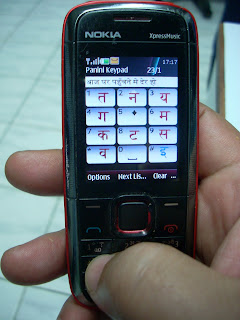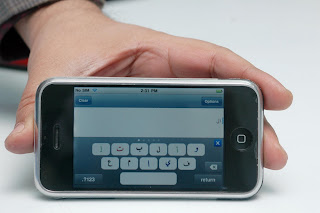Panini Keypad – Helping SMEs overcome language barriers using mobiles




Mobile users are all around us. India alone has over 700 million phone connections and definitely over 400 million unique phone users. Phone calls in India are already the cheapest in the world and the practical, social and economic advantages of staying connected are for everyone to see. These have resulted in India becoming the fastest growing mobile phone userbase in the world. It is already the second largest, close on the heels of China.
The huge mobile subscriber base also includes Small & Medium Enterprises (SMEs). These SMEs have to rely on the mobile revolution for reaching out to their customers and require Indian languages support for their various applications. The application could be a part of the service itself or could be a part of advertising and marketing campaigns which involves taking feedback & data inputs from users, interactions with customers etc. Sky is the limit for these applications where business relies on the phone for its communications within and outside the organisation.
However, if were to look at these phone users and their usage of the phone a little more closely, we will discover that most of these users do not even have an address book on their phones. They manage from last dialed numbers and have some important numbers stored in a notebook that they carry with them. How disabling is that? And they have never sent a text message. They cannot do so because they do not know English and Indian languages are not supported on the phone. And there closes the entire opportunity of digital inclusion in the form of m-governance, m-education, m-commerce, m-health and so on which are opportunities as almost everyone uses the mobile phone today. The reason behind this gap is that to do any of the above, one has to seek information, and to seek one has to type.
Supporting Indian languages on the phone (or even the computer) has remained an intractable problem for long because Indian scripts have too many characters, their word construction rules are different and complex and there are too many scripts. There are so many characters that there is no space to print them on the little face of a key and multitapping from memory is useless because it goes to 7 or 9 taps per character. Also if you put any one, say Malayalam on a phone, it becomes useless in the neighbouring province and hence that is not economically viable for any manufacturer. Therefore, how desirable and critical it may be to put Indian languages on the phone, there was no practical way to do this.
Hence, Luna Ergonomics came into existence in 2008 to provide a solution for these challenges. It's aim was to find that way to practically support Indian languages on the phone because without it, no further fruits of the telecom revolution in India would be obtainable, more critically on the data side, to interact with the possibilities of the Indian language Internet from the mobile – all that 3G and 4G would be about to 80% of India's phone users.
The solution to typing in Indian languages that takes care of all the above impediments has had to come from a patented invention of an entirely new way of typing which is supported on a basic phone as well as a modern touchscreen phone seamlessly with the same usability. The solution is called PANINI KEYPAD for Indian languages, named after the ancient Sanskrit grammarian and it already supports the 9 major languages of India namely Hindi, Bengali, Telugu, Marathi, Tamil, Gujarati, Kannada, Malayalam, Punjabi and work continues on others.
The Panini Keypad is fully developed, offered as a free downloadable from our website PaniniKeypad.com and is already being used by over a million users to type easily and fast in Indian languages on the phone to send SMS, store address book, post on facebook, send tweets etc. One can demonstrably type in Hindi faster than one can type in English on an equivalent phone using the Panini Keypad. The Panini Keypad needs no printed characters and therefore can support all the Indian languages on the same phone. There is no multitap because the average is one keypress per character entry and it does not need the user to know any English because the input is done directly in Indian script and not via English/Roman.
How does it do this?
The Panini Keypad is an intelligent responsive dynamic virtual keypad.
- In this, the limited set of characters that the user has the highest probability to type at any point of time are shown on the screen and the user can choose directly in a touchscreen device or indicate with the numeric keys of a basic phone.
- When a character is outside the predictions, the user can choose the Next List button.
- Apart from the beginning of a word, that happens very infrequently which is the demonstrated efficacy of this new technology.
- The character probabilities have all been pre-estimated through research in each Indian language independently carried out by Luna Ergonomics

The Panini Keypad estimates characters that the user could be writing next and places them according to their probabilities to positions most comfortable for the texting thumb. Also, these characters have been developed for all Indian languages.
One can experience it by downloading the usability of software from www.PaniniKeypad.com. It is also available at all leading Appstores, Getjar, OVI, Opera, operator decks etc. This new usability has brought about a dramatic improvement in the speed and ease with which one can type in an Indian script on a phone.
To understand the technology it is important to look at the following two videos.
Global usability technology?
After developing first for Indian languages, we decided to work towards other languages of the world as well. Thus we developed the technology that is running on the phone for English, Spanish, Portuguese, Arabic, French, Russian, Hebrew, Finnish, Swahili, Korean. The global family of products is branded CleverTexting. All of these languages are available as java downloadable from our website CleverTexting.com and also from iPhone Appstores under CleverTexting. And these are growing popular worldwide as the awareness of it is spreading. We have already reached promising stage of work for the Chinese language.

CleverTexting in Arabic, which offers a simpler usability to type in Arabic to send SMS and emails, now released in iTunes Appstore with several other languages including English that you must try if you have an iPhone.
The technology is not only applicable for the mobile phone but for all digital devices like the tablet, PC, IPTV, gaming consoles, STB, ATM and so on. The technology has already been developed in various platforms like Java, Android, iPhone, Windows and in native C for embedded solutions in hardware and SIMs.
This unique new technology is being hailed as a breakthrough by industry and all eminent quarters of the world including the International Telecommunication Union, United Nations of which Luna Ergonomics is one of the handful of members from India. It has won many awards including the Nasscom Foundation Social Innovation Honours 2011, Lockheed Martin India Innovation Gold Medal, Red Herring Global 100 and TieCon50, 2011
This invention has solved the problem of how Indians will be able to type on their phones in regional languages fast and easy. Go ahead, be amongst the first ones to know about it, try it.
The author is the article is Major Abhijit Bhattacharjee, Founder and CEO of Luna Ergonomics Pvt Ltd, India.

Panini Keypad surely a very helpful tool for typing in regional languages..
ReplyDelete